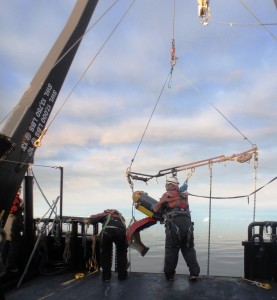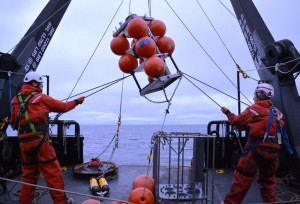2015 Research Cruise
The 2015 AMBON cruise took place 8 August – 5 September on the R/V Norseman II, starting in Prudhoe Bay and ending in Wainwright. Click here for a 2015 cruise report. A log of daily cruise activities was provided by chief scientist Katrin Iken, University of Alaska Fairbanks.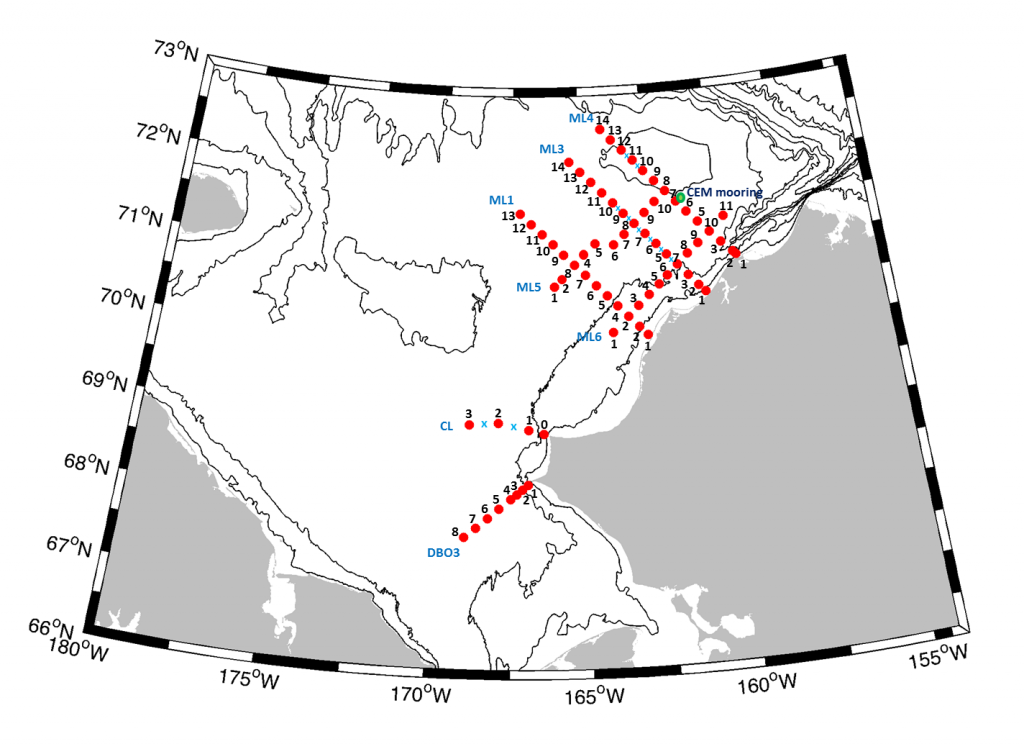
8 August 2015
The team successfully boarded the Norseman II and left Prudhoe Bay on 8 August at about 16:45 and started heading west. We are keeping inside the ice and have so far encountered flat seas and no obstacles. At 22:30 on 9 August, we attempted to retrieve the ANIMIDA buoy in Harrison Bay (70°35 N and 150°53 W) and caught it in the first attempt when grappling for it. At 7:00 on 9 August we are in Smith Bay, still progressing west in calm seas.
9 August 2015
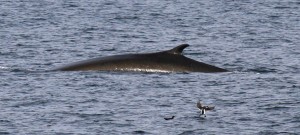 It has been another day of transit during which we passed from the Beaufort into the Chukchi Sea. Luckily, we still did not encounter any ice. The observers enjoyed calm seas and saw many phallaropes, kittiwakes and eiders. We also observed grey whales, one possible bowhead whale and several unidentified baleen whales in the far distance. At night we recovered the BC2 mooring for the ANIMIDA team (previous science team on the Norseman II) without any problems on our way south and have just passed Wainwright by the end of the night shift. The weather picked up a bit during the night but we are still making good headways.
It has been another day of transit during which we passed from the Beaufort into the Chukchi Sea. Luckily, we still did not encounter any ice. The observers enjoyed calm seas and saw many phallaropes, kittiwakes and eiders. We also observed grey whales, one possible bowhead whale and several unidentified baleen whales in the far distance. At night we recovered the BC2 mooring for the ANIMIDA team (previous science team on the Norseman II) without any problems on our way south and have just passed Wainwright by the end of the night shift. The weather picked up a bit during the night but we are still making good headways.
10 August 2015
We continued our way south towards the DBO3 sampling line. The weather stayed surprisingly calm despite the forecast, which allowed us another day of smooth transit. The seabird observers encountered several groups of Kittlitz’s murrelets, which the marine mammal observers had a very slow day with few observations. The rest of the science team is still waiting to reach the start of our study region at the DBO3 line.
11 August 2015
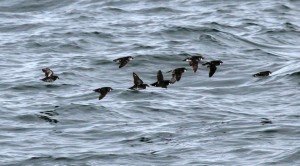 We reached our destination, the DBO3 line. The marine mammal and seabird observers surveyed the line, and saw clusters of grey whales, phallaropes, least auklets and murres around Point Hope. At night, station work began and we started working our way in from offshore to inshore along the DBO3 line. We successfully worked 5 stations during the night. Especially in the first offshore station we met a strong phytoplankton bloom.
We reached our destination, the DBO3 line. The marine mammal and seabird observers surveyed the line, and saw clusters of grey whales, phallaropes, least auklets and murres around Point Hope. At night, station work began and we started working our way in from offshore to inshore along the DBO3 line. We successfully worked 5 stations during the night. Especially in the first offshore station we met a strong phytoplankton bloom.
12 August 2015
The marine mammal observers had a slow day but the seabird observers saw large groups of least auklets and a red-breasted merganser far from shore. The night-shift team working stations finished the DBO3 line all the way to the shore and then transited up to the CL line. Close to shore the substrate was very gravelly making it impossible to sample some of the grabs and cores. Still, we are making excellent progress and are seeing rich plankton and seafloor invertebrate and fish communities.
13 August 2015
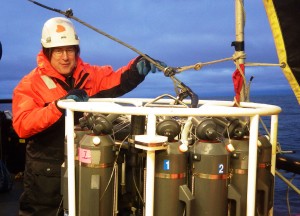 The seabird and marine mammal observers ran the entire CL line during the day from inshore to offshore but with very few sightings. At night, the station-work team back tracked the CL line and sampled stations CL3 and CL2. In between those, we completed two stations with just CTD casts to get a better resolution on the hydrography of the region. We had to spend several hours during the night to fix a problem with the CTD winch. However, this brought us to the start of our transit north just at about daybreak, giving the observers time to survey the entire transit north. So far, the weather has been mostly cooperating and we hope that it will keep this way.
The seabird and marine mammal observers ran the entire CL line during the day from inshore to offshore but with very few sightings. At night, the station-work team back tracked the CL line and sampled stations CL3 and CL2. In between those, we completed two stations with just CTD casts to get a better resolution on the hydrography of the region. We had to spend several hours during the night to fix a problem with the CTD winch. However, this brought us to the start of our transit north just at about daybreak, giving the observers time to survey the entire transit north. So far, the weather has been mostly cooperating and we hope that it will keep this way.
14 August 2015
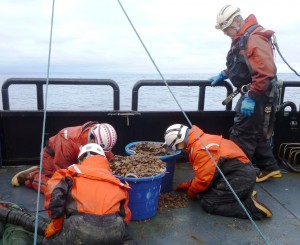 We progressed to the start (i.e., the southern end) of the ML6 line, and it was a slow day for the marine mammal observers during this long transect. The seabird observers saw some action when a parasitic and then several pomarine jaegers attacked a kittiwake but were then chased away by Arctic turns. The night-time station work team started the ML6 line and for the seafloor communities, we landed in sand dollar heaven. Just in the first trawl alone we caught 40 gal of sand dollars! The weather forecast threatens to bring us up to 30 knots but we are being optimistic that the weather will stay so we can keep up the good pace we have had so far!
We progressed to the start (i.e., the southern end) of the ML6 line, and it was a slow day for the marine mammal observers during this long transect. The seabird observers saw some action when a parasitic and then several pomarine jaegers attacked a kittiwake but were then chased away by Arctic turns. The night-time station work team started the ML6 line and for the seafloor communities, we landed in sand dollar heaven. Just in the first trawl alone we caught 40 gal of sand dollars! The weather forecast threatens to bring us up to 30 knots but we are being optimistic that the weather will stay so we can keep up the good pace we have had so far!
15 August 2015
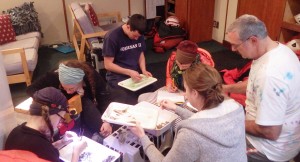 After a few slow days, the marine mammal observers finally had some good sightings again: Several gray whales, a spotted seal and a bearded seal that put on a bit of a show next to the ship, rolling around and showing his belly and flippers. In terms of birds, we mostly had the same sightings as before, a fair amount of Kittlitz’s murrelets. At night, we continued sampling the ML6 line up north. One interesting observation along this line has been that the plankton is curiously devoid of copepods. For the seafloor, we have now left the sand dollars behind us and are getting into some very diverse bottom communities of a lot of suspension feeders. One of our trawls had more than 500 fish!
After a few slow days, the marine mammal observers finally had some good sightings again: Several gray whales, a spotted seal and a bearded seal that put on a bit of a show next to the ship, rolling around and showing his belly and flippers. In terms of birds, we mostly had the same sightings as before, a fair amount of Kittlitz’s murrelets. At night, we continued sampling the ML6 line up north. One interesting observation along this line has been that the plankton is curiously devoid of copepods. For the seafloor, we have now left the sand dollars behind us and are getting into some very diverse bottom communities of a lot of suspension feeders. One of our trawls had more than 500 fish!
16 August 2015
The weather is up to 30 knots and we are hiding out close to shore, just north of Wainwright. We are using the time to catch up on data entry and sample processing, as well as finishing the assembly of the CEM mooring. Stay tuned for new updates once the weather lays down, which we hope to happen by Tuesday.
17 August 2015
We remained weathered out during Monday and stayed tucked against the shore north of Wainwright. The forecast is good enough for the next day though to commence our work on Tuesday. We plan bird and mammal observations during the day and then start station work at ML4-1 and work our way along this line. We will pick up the missing ML6-11 station on our way along the ML4 line.
18 August 2015
Today we still had to hide out during the day because of weather, but at 7pm we could finally lift the anchor and head out to station ML4-1 to start sampling again. It was still a bit rough in the beginning but soon laid down and station work went very well during the night. We sampled ML4-1, -2, and -3, and then completed the ML6 line with ML6-10 and -11. All worked well, except that we encountered some very large rocks at station ML4-3, which destroyed our trawl net. Good thing we brought a spare, which we could quickly exchange so that we were ready for more trawling again at the next station.
19 August 2015
During the day, we had more than a dozen walrus observations plus some gray whales, while it was a slow day for seabird observations. During the night, we worked 3 stations that kept us very busy. We hit a big chlorophyll peak at station ML4-7, which even clogged some of the zooplankton nets. At dawn, we were ready to retrieve the Chukchi Ecosystem mooring and re-deploy the new mooring in two parts. The operation went flawless and was extremely successful. The mooring released with no problem and was retrieved on board. The two mooring parts were then assembled and deployed, among it the sediment trap element for the first time. All in all, we had an extremely successful day and were lucky that the weather cooperated fully.
20 August 2015
The day observations today were accentuated again by several walrus sightings while it was another relatively slow day for the bird observers. Station work during the night continued working the ML4 line with stations ML4-8 through -11. At station ML4-11 we encountered a subsurface temperature maximum, an interesting feature in the water column indicating lateral advection of water masses and associated properties. We are excited to see if we can follow it further tomorrow.
21 August 2015
During the day, we continued our bird and mammal observations all the way out along the ML4 line. We saw some bowhead whales and bearded seals, and crested auklets and red as well as red-necked phalaropes. A kittiwake was observed following the ship and swooping up a gadid fish, likely an Arctic cod. The station work at night went very well, and we completed the ML4 line and then transited to the top of the ML3 line.
22 August 2015
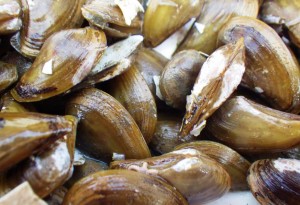 We started seabird and marine mammal observations along the ML3 line, between ML3-14 and ML3-9; however, it was a slow day for both observations. During the station work at night, we completed a record 5 stations plus one additional CTD station along the ML3 line. All worked extremely well despite some rougher weather at the beginning of the night. The highlight of our day was the experimental deployment of a modified trawl to rake for clams and coming up with more than 1000 clams as a result.
We started seabird and marine mammal observations along the ML3 line, between ML3-14 and ML3-9; however, it was a slow day for both observations. During the station work at night, we completed a record 5 stations plus one additional CTD station along the ML3 line. All worked extremely well despite some rougher weather at the beginning of the night. The highlight of our day was the experimental deployment of a modified trawl to rake for clams and coming up with more than 1000 clams as a result.
23 August 2015
 Today we completed observations for seabirds and marine mammals between ML3-9 and ML3-5. Highlights of the day were some large flocks of crested auklets and walrus and bearded seals along this line. At night, we continued stations along the ML3 line and hit “brittle star central”. At times, the whole back deck seemed to be crawling in brittle stars! We enjoyed extremely flat and calm seas all day, but we know this is just the calm before the storm that is supposed to start tomorrow.
Today we completed observations for seabirds and marine mammals between ML3-9 and ML3-5. Highlights of the day were some large flocks of crested auklets and walrus and bearded seals along this line. At night, we continued stations along the ML3 line and hit “brittle star central”. At times, the whole back deck seemed to be crawling in brittle stars! We enjoyed extremely flat and calm seas all day, but we know this is just the calm before the storm that is supposed to start tomorrow.
24 August 2015
The mammal and bird observations today along the inner part of the ML3 line took us close to chore and brought some new bird observations, such as Pacific loons, while it was relatively sparse on mammal observations. The weather was ideal during the early part of the day but started picking up in the afternoon. By evening, when the night shift came on for station work, it was marginal but still workable. We managed to finish the ML3 line because the seas got better the closer we came to shore because of the protection afforded by land in these easterly winds. However, with more weather in store for us, and winds turning to the north-west, we are expecting several uncomfortable days ahead of us with little options to hide.
25 August 2015
 Because of bad weather, no sampling took place today. Some opportunistic seabird observations were done while we worked our way close to shore towards Barrow. We anchored for a while close to Barrow and even received a brief visit from colleagues from Barrow. We appreciated the company and the ice-cream delivery! We then headed into the Beaufort Sea to find a hiding spot from the upcoming westerly winds.
Because of bad weather, no sampling took place today. Some opportunistic seabird observations were done while we worked our way close to shore towards Barrow. We anchored for a while close to Barrow and even received a brief visit from colleagues from Barrow. We appreciated the company and the ice-cream delivery! We then headed into the Beaufort Sea to find a hiding spot from the upcoming westerly winds.
26 August 2015
 As the weather continues to storm around us, we have not been able to sample today. Together with some other vessels we are hiding out close to shore just past Barrow. We are expecting several more weather days like this. Good time to catch up on data entry and processing.
As the weather continues to storm around us, we have not been able to sample today. Together with some other vessels we are hiding out close to shore just past Barrow. We are expecting several more weather days like this. Good time to catch up on data entry and processing.
27 August 2015
This has been another weather day as the storm rages around us. We have moved to Smith Bay for better protection although we are still feeling the impacts. We expect this to last at least another day before there is a chance of going out and commencing our sampling program.
28 August 2015
No sampling has been done today as we have still been hiding out from weather. We plan to transit back into the Chukchi Sea tomorrow to commence our observations and sampling.
29 August 2015
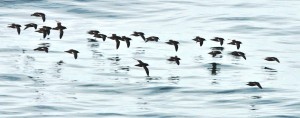 Finally, the weather laid down enough for us to make our way back into the Chukchi Sea to continue our sampling program. We used the opportunity of transit from Barrow to the top of the ML5 line for seabird and marine mammal observations across Barrow Canyon, typically a rich and productive region. And sure enough, we finally observed the large flocks of shearwaters that we have been waiting for. In addition, we saw several walrus and one gray whale displayed nicely relatively close to the boat. Farther across the Canyon, the shearwaters changed to large groups of crested auklets. At night, we started our station sampling, first still in pretty high swells but all worked very well. When crossing the other lines we have already sampled, we did repeat CTD drops but did not sample the while program again, except for some of the zooplankton nets. After 4 days of sitting and waiting it felt good to be out working again, even if accompanied by some snow!
Finally, the weather laid down enough for us to make our way back into the Chukchi Sea to continue our sampling program. We used the opportunity of transit from Barrow to the top of the ML5 line for seabird and marine mammal observations across Barrow Canyon, typically a rich and productive region. And sure enough, we finally observed the large flocks of shearwaters that we have been waiting for. In addition, we saw several walrus and one gray whale displayed nicely relatively close to the boat. Farther across the Canyon, the shearwaters changed to large groups of crested auklets. At night, we started our station sampling, first still in pretty high swells but all worked very well. When crossing the other lines we have already sampled, we did repeat CTD drops but did not sample the while program again, except for some of the zooplankton nets. After 4 days of sitting and waiting it felt good to be out working again, even if accompanied by some snow!
30 August 2015
 We had a good sampling day today, aided by seas that are calming down more and more. During the day, the bird observers had an unusual sighting for the region: a Dovekie. For mammals, we had sightings of some walrus, seals and a whale. At night, we continued and completed the ML5 line, excluding the station that crosses the ML1 line. We will work that station on our way down the ML1 line in a few days. This way, we can use the transit time to the top (offshore) of the ML1 line to observe for birds and mammals. It was a long day for all of us, but extremely productive and satisfying! The water column is very mixed after the storm and it seems that even some smaller seafloor animals have been suspended into the water column: We caught brittle stars, bristle worms and even a piece of broccoli in out zooplankton nets!
We had a good sampling day today, aided by seas that are calming down more and more. During the day, the bird observers had an unusual sighting for the region: a Dovekie. For mammals, we had sightings of some walrus, seals and a whale. At night, we continued and completed the ML5 line, excluding the station that crosses the ML1 line. We will work that station on our way down the ML1 line in a few days. This way, we can use the transit time to the top (offshore) of the ML1 line to observe for birds and mammals. It was a long day for all of us, but extremely productive and satisfying! The water column is very mixed after the storm and it seems that even some smaller seafloor animals have been suspended into the water column: We caught brittle stars, bristle worms and even a piece of broccoli in out zooplankton nets!
31 August 2015
 Bird and mammal observations overall were relatively slow today but we encountered another Dovekie and saw several walrus and seals. Our station work along the ML1 line has been progressing well. We are seeing a lot of chlorophyll in the water now compared to what we saw before the storm and we assume that the storm mixed up the water column and brought nutrients to the surface, where it can be used by phytoplankton. So, while we may not have liked the storm for our sampling, it definitely seems to have a positive effect on the ecosystem.
Bird and mammal observations overall were relatively slow today but we encountered another Dovekie and saw several walrus and seals. Our station work along the ML1 line has been progressing well. We are seeing a lot of chlorophyll in the water now compared to what we saw before the storm and we assume that the storm mixed up the water column and brought nutrients to the surface, where it can be used by phytoplankton. So, while we may not have liked the storm for our sampling, it definitely seems to have a positive effect on the ecosystem.
1 September 2015
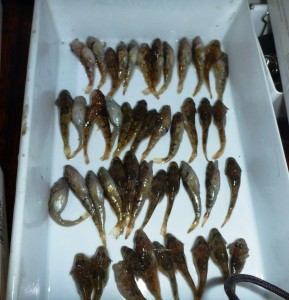 We had another very successful day. During the day, we did marine mammal and bird observations along the top of the ML1 line and saw lots of crested auklets, another Dovekie, and several seals. We completed another five stations during the night for station work, and that in record time. This is especially impressive as at one of the stations we caught more than 450 fish, among those 215 small Arctic cod, and all fish have to be individually measured. It shows the great team work we have going that we were able to accomplish all this during our 12-h night shift. We are now very close to having completed all our planned work.
We had another very successful day. During the day, we did marine mammal and bird observations along the top of the ML1 line and saw lots of crested auklets, another Dovekie, and several seals. We completed another five stations during the night for station work, and that in record time. This is especially impressive as at one of the stations we caught more than 450 fish, among those 215 small Arctic cod, and all fish have to be individually measured. It shows the great team work we have going that we were able to accomplish all this during our 12-h night shift. We are now very close to having completed all our planned work.
2 September 2015
During the day, we continued our observations of birds and mammals along the ML1 line and saw lots of Kittlitz’s murrelets and even some ancient murrelets, as well as lots of both pomarine and parasitic jaegers. A few loons flew by as well, among them at least one yellow-bill loon. Along the line we also observed several walrus and seals. During the night, we completed the ML1 line and have thus completed all the stations of the program! Wohoo! During the last 4 weeks we have done (so far, we will try to do a bit more work tomorrow) 88 CTD casts, 71 zooplankton nets, 75 bottom trawls and 30 midwater trawls! We definitely feel we have accomplished a lot and we sure have lots of samples and data to process in the next months.
3 September 2015
We started the day with observations along the ML1 line to complete our overall station plan. We saw several walrus and then a flock of about 20 spectacled eiders, which was very exciting and added a new species to the list of observations during our cruise. The weather turned on us during the day, making further observations and any station work at night impossible. We returned close to shore to seek shelter just south of Wainwright and this is where we will stay until the crew change tomorrow morning. We are just very happy about all that we have accomplished and are now hoping for improved weather for the crew change in Wainwright tomorrow. We expect this to be our last update from our AMBON cruise and hope that these updates were informative to all those interested! Thank you for following our progress!


